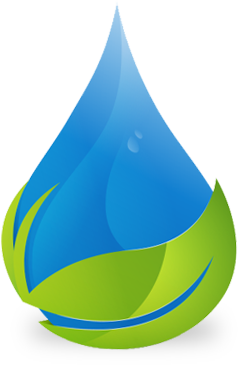Email Us :contact@ionic.co.in

Check Out Our Line of New Innovative Water, Energy, Chemical Saving Product Features
Saving water treatment cost is a popular and even desirable goal in today's industrial world and it may take different forms. One approach is to minimize purchases. The opposite method is to spend prodigiously, acquiring the best money will buy. Then, there is the middle road which is - " trying to have not the cheapest, but the best water treatment we can get for a good price". Purchase manager's and project manager's job should not be the one to purchase the lowest but to purchase a system that is value for money and will benefit the company in the long run. To attain this goal one must know the "True Cost of Water". There are many ways to reduce the water and waste treatment cost - either it will be Capex or Opex. But another better way is to look at the "Life Cycle Cost" which takes in to account the initial cost, water cost, power cost, consumable cost, maintenance cost, productivity cost, maintenance cost etc.
In water and waste water treatment, we can reduce Capex by intelligent and innovative solutions, reduce water consumption, reduce power, reduce chemicals, reduce consumables and maintenance, increase productivity and reduce waste discharge. Our water and waste water treatment solutions are based on value engineering and designed to reduce life cycle cost.
Chlorine Dosing System Manufacturers India
Water Treatment Plant Manufacturers in Pune
- Chlorine / Chlorine Dioxide Dosing System
- Chlorine Dioxide Generator
- Chemical Dosing System
- Lamella Inclined Plate Clarifier
- Solids Contact Clarifier
- Tube Settler
- Pressure Sand Filter
- Multigrade Filter
- Active Media Filter
- Activated Carbon Filter
- Iron Removal Filter
- Water Softener
- Dealkaliser
- Two Bed Demineralisers (DM)
- Mixed Bed Demineralisers (MB)
- Quick Cycle Automatic Demineralisers
- Continuous Electro Deionisation System
- Capacitive Deionisation (CDI)
- Ultra Filtration System
- Nano Filtration System
- Reverse Osmosis Plant
Chlorine / Chlorine Dioxide Dosing System
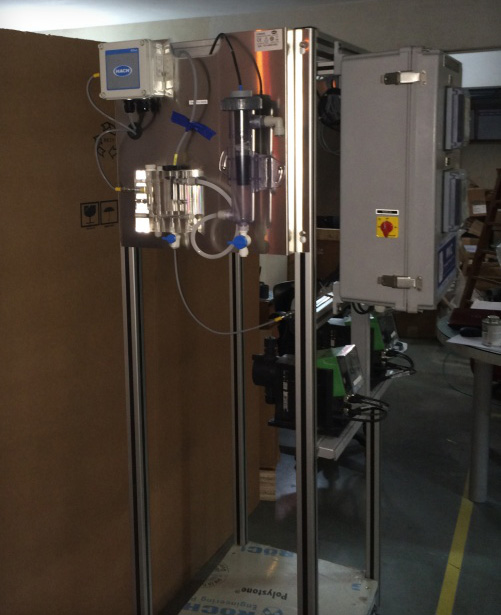 IONIC manufactures Chlorine and Chlorine Dioxide dosing system for disinfection of water and waste water. Various capacities starting from 0.1 lph to 900 lph is available. The system consists of tank of various sizes (LDPE/PP/PVC), Chemical dosing pumps (High precision Smart Digital pumps and Low cost simple dosing pumps, Tank low level switch, foot valve, injection valve. Smart digital pumps have various options for process automation and control and can accept external digital and analog signal from process analyzer and controller for automatic adjustment of dosing rate. Smart pump also can be easily connected to process automation PLC/SCADA etc. for monitoring and control purpose. IONIC can supply complete automated Chlorine and Chlorine Dioxide dosing system with Chlorine and Chlorine Dioxide analyzer.
IONIC manufactures Chlorine and Chlorine Dioxide dosing system for disinfection of water and waste water. Various capacities starting from 0.1 lph to 900 lph is available. The system consists of tank of various sizes (LDPE/PP/PVC), Chemical dosing pumps (High precision Smart Digital pumps and Low cost simple dosing pumps, Tank low level switch, foot valve, injection valve. Smart digital pumps have various options for process automation and control and can accept external digital and analog signal from process analyzer and controller for automatic adjustment of dosing rate. Smart pump also can be easily connected to process automation PLC/SCADA etc. for monitoring and control purpose. IONIC can supply complete automated Chlorine and Chlorine Dioxide dosing system with Chlorine and Chlorine Dioxide analyzer.
Chlorine Dioxide Generator
What is Chlorine Dioxide?
It is a yellowish green gas with high solubility in water and is a very powerful oxidizing chemical. It is highly unstable and hence cannot be stored or transported in bulk. Above certain concentration in air it is explosive and hence needs to be generated at site with due precautions.
Chlorine Dioxide – What you can't say from it's name. All water treatment starts with water disinfection. IONIC realised disinfecting water properly is as important as treating water and is offering a unique and cost effective solution for water disinfection.
We have developed fully automatic Chlorine Dioxide generators for water disinfection. CLO2 is 2.5 times more powerful than conventional Chlorine.
Salient Features of Chlorine Di Oxide :
There are numerous advantages of chlorine dioxide over disinfectants, notably chlorine, including:
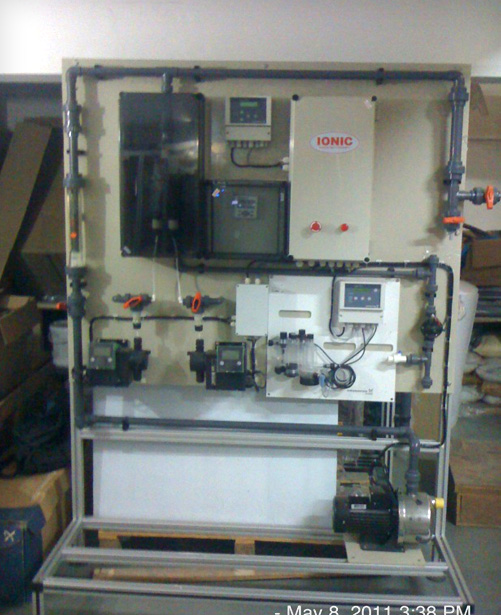 Chlorine dioxide (ClO2) has a higher disinfection potential than chlorine and is 2.5 times more powerful than chlorine.
Chlorine dioxide (ClO2) has a higher disinfection potential than chlorine and is 2.5 times more powerful than chlorine.
No pH dependence – Chlorine dioxide is an effective disinfectant, even at high pH levels where chlorine loses much of its disinfection potential.
No THM formation – Unlike chlorine, chlorine dioxide does not combine with humic or fulvic acids in surface (river) water to form trihalomethanes, suspected carcinogens.
No combination with ammonia – Chlorine dioxide does not combine with ammonia in water, like chlorine, requiring smaller doses to achieve disinfection.
No chlorophenol formation - Chlorine combines with phenols to form chlorophenols, causing taste and odor problems. Chlorine dioxide destroys phenols, eliminating many taste and odor problems.
Oxidization of iron and manganese - Chlorine dioxide rapidly oxidizes soluble iron and manganese to an insoluble state for flocculation and filtration. Chlorine alone takes days to oxide manganese, and cannot oxidize chelated iron.
Oxidizes sulfides without high pH - Sulfide oxidation using chlorine requires high pH to prevent formation of colloidal sulfur, which can plug up equipment. Chlorine dioxide may be used over a broad pH range (5-9) without colloidal sulfur formation.
No loss due to storage – Chlorine concentration in a tank of 12.5% sodium hypochlorite solution is subject to varying decay rates based on ambient conditions. Sodium chlorite and hydrochloric acid may be stored for more than a year without significant decay.
There are many methods to produce ClO2. Most other ClO2 systems mix chlorine gas and sodium Chlorite or they use acid mixed with Sodium Hypochlorite to release chlorine gas and sodium chlorite.
Method of Generation of proposed system :-
The system is designed to produce ClO2 based on acid-chlorite process. This process activates sodium chlorite with hydrochloric acid to generate chlorine Dioxide using the reaction.
5NaClO2 + 4 HCl = 4 ClO2 + 5 NaCl + 2 H2O
The generators are available in 2 versions. Smaller capacity models use dilute 9% HCl and 7.5 % NaClO2 and the larger models use concentrated chemical of 32% HCl & 25 % NaClO2. Dilution Water is added to keep the concentration in the reactor low. The Chlorine Di Oxide solution will have 2% concentration.
Chlorine Dioxide is now recognized one of the safest, most effective ideal biocides and sterilizing agent available today. As a result it is widely used in both large and small scale industrial applications where a potent but environment friendly biocide is required. Many of its uses and applications are US EPA, WHO, FDA, UK and EU government approved: and highly recommended by many researchers and research establishments throughout the word.
Chemical Dosing System
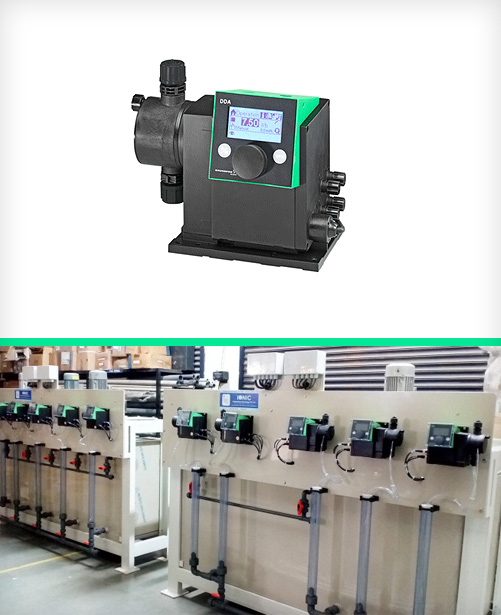 The system will be pre-engineered, prewired and tested prior to dispatch for speedier installation and commissioning at site. The dosing system will be housed in a skid with optional integrated drip tray.
The system will be pre-engineered, prewired and tested prior to dispatch for speedier installation and commissioning at site. The dosing system will be housed in a skid with optional integrated drip tray.
We recommend Smart Digital dosing system for metering chemicals accurately in to the process stream. Chemistry in water treatment, water and waste water treatment and recycling has experienced a huge development during the last years, and this poses a challenge for today's dosing technology. More and More complex applications require intelligent dosing pumps with new drives or new control and adjustment mechanisms to simplify the operator's job.
Smart Digital Chemical metering pumps meet these challenges. They offer state of the art drive technology, new dimensions of user – comfort and intelligent flow control. These features ensure extremely reliable, cost-effective, and high precision processes at an optimum price-performance ratio. Some of the salient features and advantages of Smart Digital Dosing pumps are Designed to save cost and save environment
In general investment for a dosing pump installation is low compared to its life cycle costs. Low operation costs and longer maintenance intervals combined with an extremely high accuracy make Smart Digital a perfect partner for:
- Saving chemicals with high accuracy and flow control
- No under dosing and over dosing
- Ensuring process reliability
- Reducing cost of compliance
- Saving energy with latest drive technology and improved electronics
- Saving maintenance costs thanks to the universal chemical resistance of the full –PTFE diaphragm and digital dosing
The system can be operated through external digital and analog signal and can provide digital and analog outputs to PLC and process control automation purpose. For more information contact us with your application.
Typical Applications
- Dosing of coagulants in water and waste water treatment
- Dosing of Poly electrolytes in
- Dosing of SMBS before R.O system
- Dosing of precise quantity of antiscalant before R.O
- Dosing of Cooling tower chemicals
- Dosing of boiler feed chemicals
- Dosing of chemicals used in waste water treatment
- Dosing of process chemicals in paint shops, chemical processes etc.
Lamella Inclined Plate Clarifier
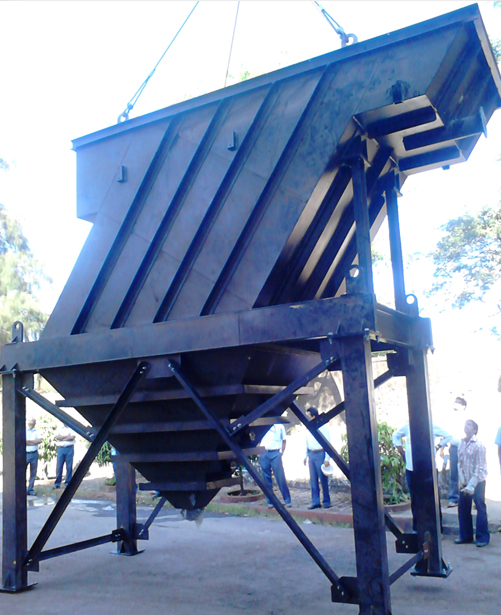 Ionic Lamella plate clarifier configuration ensures laminar flow conditions, which results in hydraulic uniformity and high effluent quality. It permits great reduction in the space needed for clarification equipment and allows the compact equipment to be located indoors if desired, or to be easily relocated at a later date. It also makes point-source treatment not only feasible, but logical for many applications. The Lamella Clarifier system consists of a series of inclined overlapping plates, which are arranged to form separate sedimentation chambers or cells between each pair of adjacent plates. The overlapping additive projected area of the plates is a factor of increased surface settling which is proportional to the number of plates used.
Ionic Lamella plate clarifier configuration ensures laminar flow conditions, which results in hydraulic uniformity and high effluent quality. It permits great reduction in the space needed for clarification equipment and allows the compact equipment to be located indoors if desired, or to be easily relocated at a later date. It also makes point-source treatment not only feasible, but logical for many applications. The Lamella Clarifier system consists of a series of inclined overlapping plates, which are arranged to form separate sedimentation chambers or cells between each pair of adjacent plates. The overlapping additive projected area of the plates is a factor of increased surface settling which is proportional to the number of plates used.
KEY ADVANTAGES OF LAMELLA CLARIFIER SYSTEM
- No moving parts, thereby minimizing maintenance.
- Time required to stabilize the Lamella Clarifier system after start up is only approximately 20 minutes.
- Continuous operation possible for any length of time without shutdown
- Sludge thickener zone having four sloped hopper bottoms replaces the extra thickener
- Maximum projected effective settling area(PESA) per m2 of plate area available due to better hydraulic distribution and collection systems
- Each plate is constructed of FRP corrosion resistant material
- Lifting arrangements are not required for plate installation or inspection individual Lamella plates can be easily removed and installed during installation or maintenance by a single operator without the need to shut down the system
- Internal flow feed ducts ensure even distribution of water to each and every plate controlling velocity and thereby minimizing turbulence
- Adjustable weir plates ensure even collection of the treated water without short circuiting
- The tank and structural support design is completely self supporting for continuous working conditions and is also compatible with supporting walkways, ladders etc. The flash mix cum flocculation tank is a one piece configuration for bolt up to the lamella tank in the field.
- Manual floor space and building height clearances required
- The Lamella Clarifier system design is such that it does not build up deposits, thereby minimizing the frequency of cleaning as well as other maintenance problems usually faced with conventional clarification
The Lamella Clarifier system design is such that it does not build up deposits, thereby minimizing the frequency of cleaning as well as other maintenance problems usually faced with conventional clarification
Available Options :
- Flash mix/flocculation tanks with mixers
- Full FRP or stainless steel construction
- Concrete tank designs
- Special coatings and plate materials
- Integral mechanical sludge thickener
- Access platform and ladder
- In-house laboratory analysis
- Potable water design
- Gasketed and removable covers
- Automatic desludging
- Instrumentation and controls
- Chemical feed equipment
- Sludge handling and dewatering
- Pilot size units for on-site testing
Typical applications
- Fly Ash Waste
- Flue Gas Desulfurization (FGD) Waste
- Clarification
- Solids Recovery
- Cooling Tower Blowdown
- Iron Removal
- Municipal Water Treatment
- Semiconductor Process Waste
- Whitewater (Pulp & Paper)
- Groundwater Remediation
- Potable Water Clarification
- Boiler Waste Treatment
- Landfill Leachate
- Heavy Metals Removal
- Filter Press Belt Wash
- Battery Plant Heavy Metals Removal
- Hazardous Waste Remediation
- Brine Clarification
- Plating and Finishing Wastes
- Food & Beverage Waste
- Trace Metals Reduction
- Storm Water Management
- Bleach Plant Wash Water
- Incinerator Wet Scrubber
- Potable Water Pretreatment
Solids Contact Clarifier
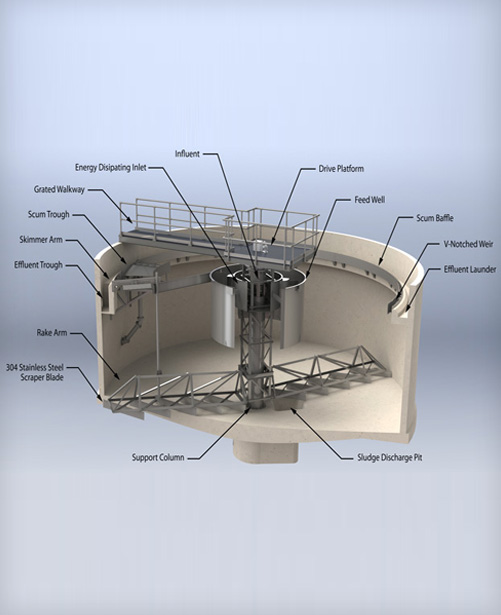 Solids contact Clarifier is a well-established solid liquid clarification process for effective and efficient removal of suspended solids and other physical contaminants from wastewater. It is a high rate clarifier, which, in minimum time and space and using a minimum of chemicals, produces an effluent of highest quality. It is principally used for coagulation, flocculation and clarification of water and waste water containing suspended solids, colour and organic impurities
Solids contact Clarifier is a well-established solid liquid clarification process for effective and efficient removal of suspended solids and other physical contaminants from wastewater. It is a high rate clarifier, which, in minimum time and space and using a minimum of chemicals, produces an effluent of highest quality. It is principally used for coagulation, flocculation and clarification of water and waste water containing suspended solids, colour and organic impurities
Coagulants such as ferrous sulphate, lime and polymer are added for effective precipitation. The solids contact clarifier water and waste water treatment solution is designed to ingeniously combine flash mixing followed by slow speed agitation and settling in one central zone whereby reducing retention time as required for conventional clarifier. This results in effective reduction in the equipment sizes as well as substantial savings in the utilization of treatment chemicals.
As such, the solids contact clarifier provides a means for chemical addition and mixing, flocculation, and upflow clarification in a single unit. In operation, raw water, chemicals, and a large quantity of recirculated precipitates are thoroughly mixed in the draft tube (mixing section). These are maintained in intimate contact for a prolonged period under the detention hood (flocculation zone). The contact between the water treatment chemicals and the preformed precipitates causes additional precipitation, and the recirculated floc particles rapidly grow to an exceptionally large size and high density. In addition, the large volume of recirculated precipitates provides an adsorptive surface that maximizes the reduction of color and organics.
Tube Settler
 For small flow rates and low cost solid liquid separation in water and waste water treatment
For small flow rates and low cost solid liquid separation in water and waste water treatment
Tube settler systems are an inexpensive solution for small flow rate drinking water and wastewater plants to increase treatment capacity, reduce new installation footprints, improve effluent water quality, and decrease operating costs. Constructed of lightweight PVC, tube settler modules can be easily supported with minimal structures that often incorporate effluent troughs and baffles. Modules are available in a variety of sizes to fit any tank geometry and tube lengths to accommodate a wide range of flows. With years of experience and extensive knowledge of the water treatment process, ionic can provide full process design for economically packaged systems.
Tube settlers are not as efficient as lamella Inclined Plate Clarifier. However they are popular and widely sued for its low cost and small foot print.
Typical application
- Potable water clarification
- Waste water clarification
- Sewage treatment system secondary clarifier for biomass removal
Pressure Sand Filter
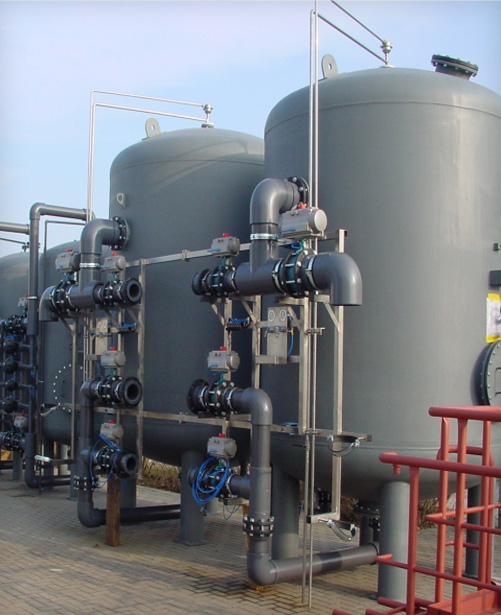 Pressure sand filter consists of a M.S / FRP pressure vessel with frontal pipe work and valves for easy of operation. The pressure vessel is filled with carefully selected grade of sand filter media for filtering out the suspended solids and turbidity.
Pressure sand filter consists of a M.S / FRP pressure vessel with frontal pipe work and valves for easy of operation. The pressure vessel is filled with carefully selected grade of sand filter media for filtering out the suspended solids and turbidity.
Under bed media of various grades and sizes support the filter media. The filter is backwashed regularly with filtered water and while filtering raw water having high turbidity and suspended solids air scouring is recommended to fluidized the bed and ensure complete removal of trapped solids.
Filters are available in various capacities starting from 1.0 m3/hr to several hundred thousand litres.
Multigrade Filter
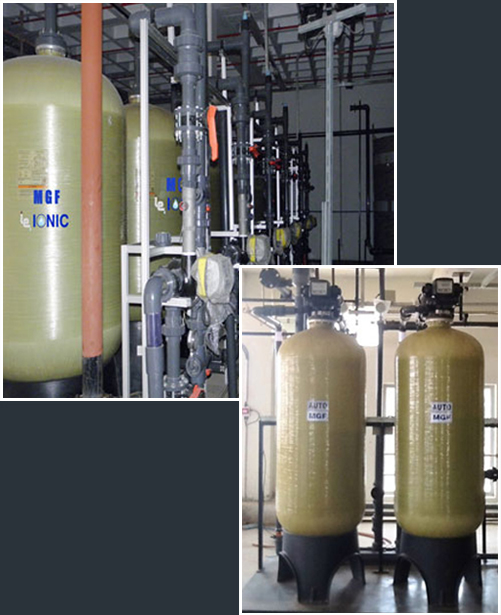 IONIC "Next Generation" Multigrade filter uses carefully selected and mixed grade of filter media for effective filtration of water having turbidity up to 50 NTU. The filter unlike conventional pressure sand filters uses "VARY VOID" principle for depth filtration and operates at higher specific velocity and needs back wash once a day. They also consume less amount of water during backwash operation. Automatic and manual versions are available.
IONIC "Next Generation" Multigrade filter uses carefully selected and mixed grade of filter media for effective filtration of water having turbidity up to 50 NTU. The filter unlike conventional pressure sand filters uses "VARY VOID" principle for depth filtration and operates at higher specific velocity and needs back wash once a day. They also consume less amount of water during backwash operation. Automatic and manual versions are available.
Benefits
- They work at thrice the surface velocity of conventional filters
- Deep bed filtration
- Back wash once in 24 hours with raw water 25 NTU turbidity
- Low waste water generation
- Reduced diameter for the same flow
- Reduced system cost
- Aesthetically good
- Light weight easy to install
- Corrosion resistant FRP/Composite pressure vessel
- No foundation required
- Small space requirement
- Single lever operated Multiport valve
- Semi automatic/Fully automatic option
- < 2 NTU turbidity
APPLICATION
- Potable water filtration
- Industrial water filtration
- Cooling water filtration
- Treated sewage water
- Treated industrial waste water filtration
- Swimming pool filtration
Active Media Filter
Active Media Filter system is required when there is need of high quality reliable filteration
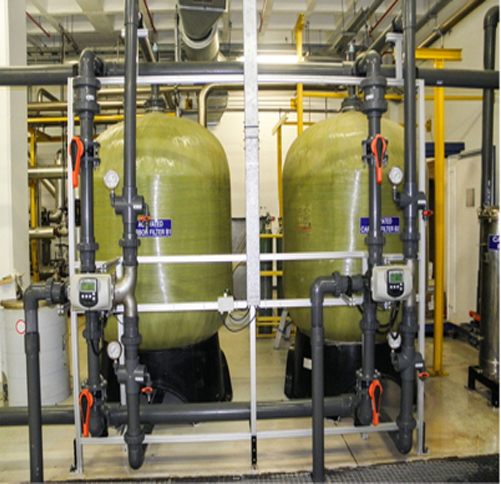 AFM active filter media replaces sand in all types of sand filter. The high surface negative charge potential helps to adsorb micron and sub-micron particles as well as some dissolved organics. Over 40,000 installations around the world for pools, irrigation, drinking water and wastewater treatment.
AFM active filter media replaces sand in all types of sand filter. The high surface negative charge potential helps to adsorb micron and sub-micron particles as well as some dissolved organics. Over 40,000 installations around the world for pools, irrigation, drinking water and wastewater treatment.
What is AFM ?
AFM® is an activated amorphous alumino-silicate filtration media with positive charge organic adsorption (OAD) number greater than 10, the activated hydrophilic surface has cation bridging, hydrogen bonding and entropic interactions with organic molecules.
- Electro-mechanical filtration media with chemically activated surface.
- Does not biofoul and is not subject to worm-hole channeling.
- Certified for drinking water under UK, European and International regulations.
- Perfect for the tertiary treatment of waste water in pressure or RGF filters.
- At least 50% better performance than sand, confirmed by nation government organisations.
- Will help reduce THM precursors in drinking water systems.
- High performance removal of crypto oocysts, especially when combined with coagulant
- Should never need to be changed, will last for the life of the filter.
- More expensive than sand, but return in capital out of revenue savings is measured in months.
Activated Carbon Filter
Activated Carbon Filter (ACF) is when free chlorine, Organics, Colour, Odour Removal from water is required
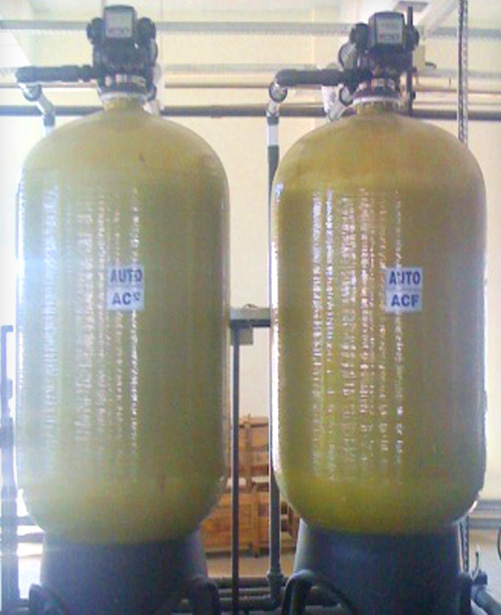 Ionic manufactures manual and fully automatic Activated Carbon filter for the removal of free chlorine, chlorine dioxide, colour, odour and organics from water. The heart of the system activated carbon media is carefully selected for various performance related parameters like iodine value, surface area etc.
Ionic manufactures manual and fully automatic Activated Carbon filter for the removal of free chlorine, chlorine dioxide, colour, odour and organics from water. The heart of the system activated carbon media is carefully selected for various performance related parameters like iodine value, surface area etc.
For special applications when microbial control is required for food & beverage industries and pharmaceutical applications hot water sanitation option is available.
IRON REMOVAL FILTER – WHEN DISSOLVED IRON IN WATER NEEDS TO BE REMOVED
Ionic manufactures iron removal filter for removing dissolved iron in water. Using special granular media these filters can remove up to 10 ppm of dissolved iron from water.
The filters do not use chemicals and are back washed with water. The filter media remains effective as long as feed water contains dissolved oxygen to the extent of its natural solubility.
The filters are available in manual and automatic models.
Applications
- Drinking water treatment
- Pretreatment to industrial water treatment plants
- Beverages, food processing and bottled water
Iron Removal Filter
Iron Removal Filter - When dissolved iron in water needs to be removed
Ionic manufactures iron removal filter for removing dissolved iron in water. Using special granular media these filters can remove up to 10 ppm of dissolved iron from water.
The filters do not use chemicals and are back washed with water. The filter media remains effective as long as feed water contains dissolved oxygen to the extent of its natural solubility.
The filters are available in manual and automatic models.
Applications
- Drinking water treatment
- Pretreatment to industrial water treatment plants
- Beverages, food processing and bottled water
Water Softener
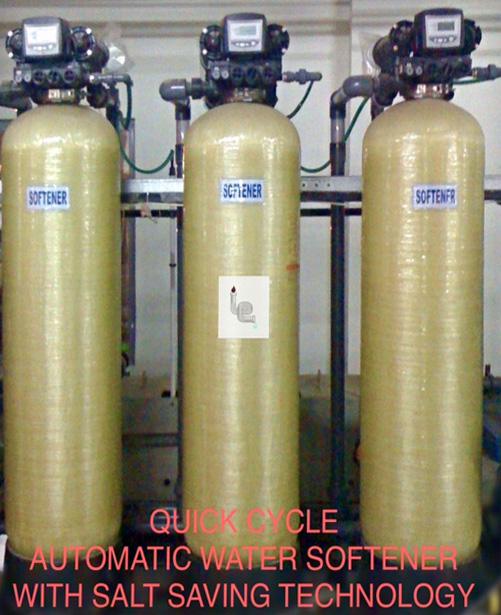 IONIC manufactures a range of standard water softening plants starting from 500 lph to 50000 lph. We manufacture both manually operated as well as fully automatic plants. We also offer fully automatic water softeners with "Salt Saving Technology" by which 30-40% of the salt and 30% water used for regeneration can be reduced. The automatic softener ensures consistent quality of soft water and reduces human error. Optional online water hardness monitor can be provided for initiating the regeneration based on outlet water hardness thus saving salt and water. The automatic options available are
IONIC manufactures a range of standard water softening plants starting from 500 lph to 50000 lph. We manufacture both manually operated as well as fully automatic plants. We also offer fully automatic water softeners with "Salt Saving Technology" by which 30-40% of the salt and 30% water used for regeneration can be reduced. The automatic softener ensures consistent quality of soft water and reduces human error. Optional online water hardness monitor can be provided for initiating the regeneration based on outlet water hardness thus saving salt and water. The automatic options available are
Special features
The fully automatic softeners are attractive, compact, easy to operate and maintain and use international quality material of construction which are corrosion resistant. The softeners are light weight and use 65-70% less components to make it more reliable and reduce maintenance and replacement parts. Thus they are cheaper to maintain too!
Fully automatic control valves:- Sourced from quality international manufacturers known for reliability they have outstanding features and reliability which is not available in locally sourced valves. All valves are application specific microprocessor based with digital display for control and monitoring and facilitate easy integration with process control and automation.
The automatic options available are
- "SINGLE" tank system – for simple low volume application
- "TWIN SOFTENER" – both working in parallel
- "TWIN SOFTENER" - both working in series
- "TWIN ALTERNATING SOFTENER" - one working and one standby
- "TRIPLE TANK' system – two working and one standby
The salient features of the plants are
- Corrosion resistance FRP & Composite pressure vessels
- Premium grade ion exchange resins with the option of "salt saving technology" which will reduce salt consumption by 30-40% compared to conventional softeners
- Imported high quality microprocessor based automatic valves for smooth reliable operation
- Inbuilt flow sensor for measurement of instantaneous flow rate and total volume of water treated.
Typical applications
- Cooling water make up
- Boiler feed water for low pressure boilers
- Textile processing
- Beverage production
- Bottle washing water
- Pretreatment to R.O plant
- Hospitals, Hotels, Laundries and Air conditioning plants
- Many other applications when soft water is required
Dealkaliser
Dealkaliser - When Alkalinity and Carbonate hardness reduction from water is required
.jpg) Dealkalisation involves removal of the Temporary Carbonate Hardness (Hardness associated with Alkalinity) in the raw water in a Weak Acid Cation, so that the Total Dissolved Solids reduces along with the Hardness. To remove the free CO2 liberated in the Weak Acid Cation, a degasser system is used. The effluent from cation column will be acidic in nature and hence pH correction will be required. Application areas are boiler feed, cooling tower make up, carbonated soft drinks and partial desalination to reduce hardness, alkalinity and TDS in the raw water. The Operation of the Dealkaliser is automatic.
Dealkalisation involves removal of the Temporary Carbonate Hardness (Hardness associated with Alkalinity) in the raw water in a Weak Acid Cation, so that the Total Dissolved Solids reduces along with the Hardness. To remove the free CO2 liberated in the Weak Acid Cation, a degasser system is used. The effluent from cation column will be acidic in nature and hence pH correction will be required. Application areas are boiler feed, cooling tower make up, carbonated soft drinks and partial desalination to reduce hardness, alkalinity and TDS in the raw water. The Operation of the Dealkaliser is automatic.
Dealkaliser has many operational benefits in a water treatment process compared to having softening plant alone for removing hardness from water. The benefits are:
- Selectively removes temporary carbonate hardness from the feed water
- Has high selectivity for hardness associated with alkalinity
- Weak acid cation exchange resin has very high operating exchange capacity ( gms. salt removed/ Litre of resin used) compared to softener resins.
- Very high regeneration efficiency (5% extra regenerant required based on stoichiometric requirement) compared to softener resins (softener resins require extra salt of 50-60% stoichiometric requirements.
Typical applications
- Cooling water make up
- Boiler feed water for low pressure boilers
- Beverage production
- Bottle washing water
- Pretreatment to R.O plant
- Air conditioning plants
- Many other applications when Alkalinity , TDS reduction is required
Two Bed Demineralisers (DM)
Demineralising Plant (DM Plant) - When complete removal of dissolved salts are required
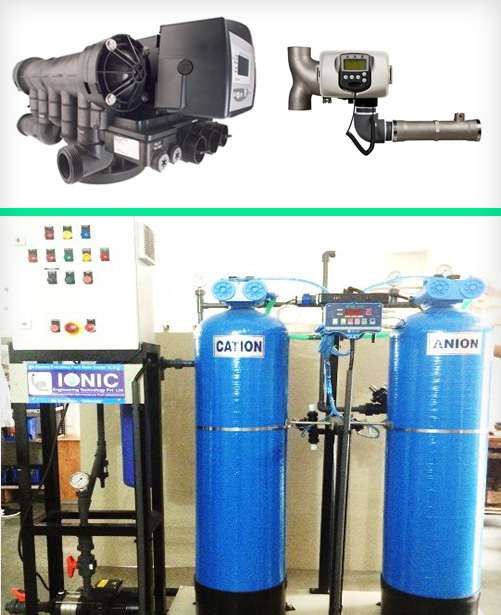 IONIC manufactures conventional ion exchange manually operated two bed and mixed bed demineralsising plant as well as advanced fully automatic Quick Cycle auto D.M plants. Various schemes and sizes depending on raw water characteristics and final treated water characteristics can be offered based on application and project specific requirement. The flow rate is available from 500- 50000 lph for standard models and large capacities are custom designed.
IONIC manufactures conventional ion exchange manually operated two bed and mixed bed demineralsising plant as well as advanced fully automatic Quick Cycle auto D.M plants. Various schemes and sizes depending on raw water characteristics and final treated water characteristics can be offered based on application and project specific requirement. The flow rate is available from 500- 50000 lph for standard models and large capacities are custom designed.
Industrial mixed bed demineralizers are recommended for polishing of two bed demineralizer treated water.
The application areas are process water, boiler feed make up, ultra pure water treatment etc. when absolute removal of dissolved inorganic chemicals are required.
Typical applications
- Process water demineralization
- Boiler water demineralization
- Pharmaceutical water systems
- Battery water production
- Diesel engine cooling water make up
- Glass washing water
- Lens cleaning
Mixed Bed Demineralisers (MB)
.jpg) There are many industrial processes in which the presence of any dissolved salts in water can cause problems. Removing all the dissolved salts from water is called deionisation or demineralisation. Processes that need high purity water include: High pressure boilers, Chemical manufacture, Toiletries and cosmetics production, Humidification systems, Battery top-up, Surface finishing, etc.
There are many industrial processes in which the presence of any dissolved salts in water can cause problems. Removing all the dissolved salts from water is called deionisation or demineralisation. Processes that need high purity water include: High pressure boilers, Chemical manufacture, Toiletries and cosmetics production, Humidification systems, Battery top-up, Surface finishing, etc.
For industrial processes requiring high purity water, the most widely used purification technology is twin bed ion exchange deionisation. The ion exchange resins are contained in two separate pressure vessels and flow through them in series. Raw water enters the cation exchange vessel and passes down through the resin bed where calcium, magnesium, sodium and other cations are removed from the water in exchange for hydrogen ions. The water then passes through the anion exchange vessel where chloride, sulfate, bicarbonate and other anions are removed in exchange for hydroxide ions. When the hydrogen and hydroxide ions on the resins have been replaced by the cations and anions from the water, the deionisation reaction stops and the resins need to be regenerated.
Industrial Mixed bed demineralisers consistent of a single column pressure vessel in which strong acid cation and strong base anion exchangers resins are intimately mixed together. Water passing through the exchanger repeated comes in contact with these resins and is thus in effect subjected to almost infinite number of demineralizing stages. Demineralised water of very low conductivity (<1 .0 micro Siemens/cm) and low reactive silica content is produced.
MB units are regenerated with acid and alkali upon exhaustion of the resin. Generally two bed demineralized water is taken as feed to the MB unit and occasionally Ro permeate and filtered water having < 100 ppm TDS can be fed to the system.
Treated water quality
- Specific conductivity - < 1 µS/cm @25 deg c < 0.05 ppm
- pH – 6.8-7.2 when measured online
- TDS < 0.5 ppm
Quick Cycle Automatic Demineralisers
(1).jpg) IONIC offers its unique skid mounted compact, pre-engineered Fully automatic PLC controlled "Quick Cycle" demineralisers with "Chemical saving technology" for producing demineralised water having conductivity < 1.0 µS/cm. All components are carefully selected to give long term reliable performance. Advanced safety features have been incorporated for reliable operation 24 hrs. and 365 days a year. Optionally print out facility and Remote Real time monitoring can be provided for critical parameters.
IONIC offers its unique skid mounted compact, pre-engineered Fully automatic PLC controlled "Quick Cycle" demineralisers with "Chemical saving technology" for producing demineralised water having conductivity < 1.0 µS/cm. All components are carefully selected to give long term reliable performance. Advanced safety features have been incorporated for reliable operation 24 hrs. and 365 days a year. Optionally print out facility and Remote Real time monitoring can be provided for critical parameters.
There are over 24 models to choose from to cover flow rate from 1.5 m3/h to 35 m3/h and to meet different Di water quality requirements. Pl. refer to our brochure for technical details.
- Very compact
- Fully automated PLC controlled
- Skid mounted
- Corrosion resistant construction
- Pre-engineered and tested
- 24 Models and 8 flow capacities
- High quality of treated water
- Low chemical consumption
- Low power consumption
- Low water consumption
- Mixed bed quality without Mixed bed
- Unattended operation
- Unique safety features
- Highly reliable components
- Low maintenance cost
- High quality UPVC piping and valves
- High quality SS 316 multistage process pump
- High quality control panel
- FRP/M.S/SS-304 skid option
- Printout facility option
- Remote Monitoring Option
- Integrated Pretreatment
- Bulk regenerant chemical handling system
Continuous Electro Deionisation System
Continuous Electro Deionisation is when chemical free Deionisation / Demineralistion is required
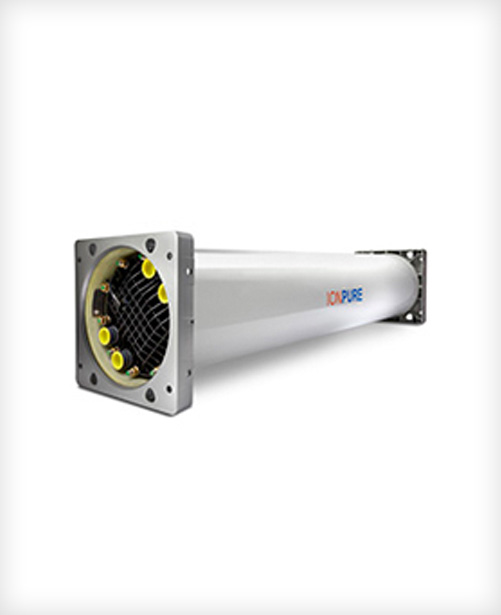 CEDI process means it removes ions from liquid by using electrically active media and by using electric potential to influence the ion transport. In the module, direct current is applied to the anode (positive electrode) on one end of the module, and to the cathode (negative electrode) on the other end. Compartments of CEDI are hydraulically in parallel and electrically in series. Resins are filled between Cation & Anion exchange membrane in the dilute chamber, because resins are more conductive than solution. This electric potential drives the ions captured by the ion exchange resins through the membrane. Because of the electric current, water catalyze splitting continuously due to that resins are continuously regenerated in the module, they do not become exhausted. This continuous electro- regeneration enables continuous production of multi-mega ohm water without the need for chemical regeneration or downtime.
CEDI process means it removes ions from liquid by using electrically active media and by using electric potential to influence the ion transport. In the module, direct current is applied to the anode (positive electrode) on one end of the module, and to the cathode (negative electrode) on the other end. Compartments of CEDI are hydraulically in parallel and electrically in series. Resins are filled between Cation & Anion exchange membrane in the dilute chamber, because resins are more conductive than solution. This electric potential drives the ions captured by the ion exchange resins through the membrane. Because of the electric current, water catalyze splitting continuously due to that resins are continuously regenerated in the module, they do not become exhausted. This continuous electro- regeneration enables continuous production of multi-mega ohm water without the need for chemical regeneration or downtime.
Application areas
Industrial high purity process water, High purity process water for high pressure boiler make up, High purity pharmaceutical water grade generation, Ultrapure semiconductor / electronics grade water generation, lab grade high purity water generation.
Typical applications
- High pressure boiler feed water demineralization
- High purity Ultrapure water for semi-conductor / electronics / solar photovoltaic
- High purity water for industrial process water
- High purity water for pharmaceutical water
- High purity water for cleaning of parts. Glass, lens etc
Capacitive Deionisation (CDI)
.jpg) With the need for water increasing day by day due to population growth and increased industrial activity the time has come to think seriously about sustainability and reducing your water foot print. In addition to this reducing power, chemical and waste becomes important. This calls for an alternative innovative approach to water treatment than traditional approach.
With the need for water increasing day by day due to population growth and increased industrial activity the time has come to think seriously about sustainability and reducing your water foot print. In addition to this reducing power, chemical and waste becomes important. This calls for an alternative innovative approach to water treatment than traditional approach.
IONIC introduces an innovative patented treatment technology called Cap Di that takes into account the above requirement and reduces the life cycle cost.
For Desalination, an innovative technology called Capacitive Deionisation - CDI is used. This technology can treat ground or surface water containing high dissolved salts to take out all contaminants like Fluoride, Nitrates, Arsenic, Hardness etc, to produce clean drinkable water and process water that meets WHO/IS standards. With limited single source supply many industrial units are forced to depend on multiple sources with different characteristics for various processes. This affects the treatment process as well reduces the reliability of the same.
This technology differs from the traditionally Reverse Osmosis systems as it discharges much less waste water, consumes low power and does not use chemicals during purification / treatment process. The overall operating costs are also low since it does not use semi permeable membranes and the total consumables are less.
How this works ?
The system comprises of "CDI Cells" which has several electrodes stacked in a compact case
Water is sent through these electrodes at a very low pressure and as water flows through these electrodes a voltage difference is applied (forming a capacitor) between them to disassociate ions present in water.CDI Cells uses different coupled electrodes contained in a pressurized container, these electrodes are placed at a distance of 100 microns to ensure maximum contact with water.
As water moves through these electrodes, a direct current at a potential difference of < 1.6 Volt is supplied. This creates an electrostatic field that attracts the ions dissolved in water to the electrodes. Operating as low voltages, electrolysis and gas production will not occur. The result is the partial or total demineralization of the water.
The electrodes behave like those of a normal condenser. At a certain point, the ions will cover the whole surface of the electrodes saturating them. When this occurs, the system senses the potential difference and automatically reverses the polarity of the electrodes. By doing so, the ions that are stuck to the electrodes gets disengaged. The result is a high concentration of dissolved ions that are now sent to drain.
Once the ions get discharged, the polarity is brought back to normal and the entire process of deionization starts again. This entire process is done automatically in through a smart controller that senses when to regenerate the electrodes and when to start production.
The picture below shows the process of deionization and regeneration in CDI cells.
Typical applications
- Drinking water treatment – brackish water desalination
- Process water treatment
- Cooling tower make up
- Boiler feed water make up
- Pretreatment to D.M plant
- Pretreatment to R.O plant
- Post treatment to RO plant
- RO reject recovery and recycle
- Waste water recycling
- Zero Liquid discharge (ZLD) system
- Closed loop recycling
Ultra Filtration System
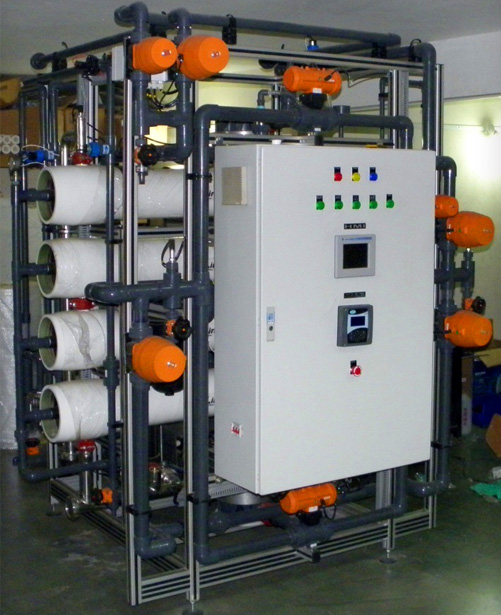 To protect the down stream RO or CDI system from fouling we propose a ultra filtration system which will remove ultrafine particulate matter, algae and bacteria and make the water suitable for further desalination.
To protect the down stream RO or CDI system from fouling we propose a ultra filtration system which will remove ultrafine particulate matter, algae and bacteria and make the water suitable for further desalination.
Ultrafiltration (UF) is a pressure-driven process that removes emulsified oils, metal hydroxides, colloids, emulsions, dispersed material, suspended solids, and other large molecular weight materials from water and other solutions. UF membranes are characterized by their molecular weight cut-off.
UF excels at the clarification of solutions containing suspended solids, bacteria, and high concentrations of macromolecules, including oil and water, fruit juice, milk and whey, electrocoat paints, pharmaceuticals, poly-vinyl alcohol and indigo, potable water, and tertiary wastewater.
Avoid Pretreatment – The IONIC UF system's high flux and solids tolerance properties can eliminate the need for costly clarifiers and chemical pretreatments in tough applications.
Less Downtime – Polyester reinforced membranes and a unique single potting design help to avoid downtime associated with frequent cleaning cycles, sludging and fiber repair.
Less Chemicals – Superior chemistry and a tight pore structure deliver more stable membrane performance without the need for extensive chemical cleans.
Simple Operation – Minimal system connections, an intelligent user interface and outstanding membrane reliability make IONIC UF one of the easiest-running filtration systems available.
Save Money – Superior output, simplified operation, reduced maintenance and pretreatment costs and a compact footprint all add up to cost savings for you!
Ultra filtration or UF is a semi - permeable membrane controlled pressure driven process capable of performing a variety of selective separations. In Ultra filtration, the process feed solution flows across a membrane with pore diameters in the range of 10 angstroms to 200 Angstroms. This is a pressure driven membrane separation process that separates particulate matter from soluble components in the carrier fluid (such as water). UF membranes typically have pore sizes in the range of 0.01 - 0.10 µm and have a high removal efficiency for bacteria and most viruses, colloids and silt (SDI), the smaller the nominal pore size, the higher the removal efficiency. Most materials that are used in UF are polymeric and are naturally hydrophobic. Common polymeric materials used in UF include: Polysulfone (PS), Polyethersulfone (PES), Polypropylene (PP), or Polyvinylidenefluoride (PVDF). Although these materials can be blended with hydrophilic agents, the hydrophilic additives can reduce the membranes ability to be cleaned with strong levels of disinfectants such as peroxide or hypochlorite to sufficiently remove bacterial growth.
IONIC uses several different type of membranes depending on the application and feed water characteristics. Contact us with your requirement and we shall recommend a suitable system.
TYPICAL APPLICATIONS
- Surface water filtration for drinking and process water
- Pretreatment to reverse osmosis plant to remove suspended solids, turbidity and control Silt Density Index (SDI)
- Part of Tertiary waste water treatment when recycling of waste water is required
Nano Filtration System
IONIC offers NANO filtration system for speciality membrane based applications like hardness removal, caustic recovery, dye recovery, metal recovery, nonalcoholic beer production etc. Contact us with your specific requirement and we shall provide you the right solution.
Nano filtration is a technique that has prospered over the past few years. Today, nano filtration is mainly applied in drinking water purification process steps, such as water softening, decolouring and micro pollutant removal.
During industrial processes nano filtration is applied for the removal of specific components, such as colouring agents. Nano filtration is a pressure related process, during which separation takes place, based on molecule size. Membranes bring about the separation. The technique is mainly applied for the removal of organic substances, such as micro pollutants and multivalent ions. Nano filtration membranes have a moderate retention for univalent salts.
Typical Applications
- The removal of pesticides from groundwater
- The removal of heavy metals from wastewater
- Wastewater recycling in laundries
- Water softening
- Nitrates removal
Reverse Osmosis Plant
Reverse Osmosis Plant - When Desalination of Brakcish and sea water is required
.jpg) Reverse osmosis process is a membrane process in which a synthetic semi permeable membrane is used to separate water from dissolved impurities. When a semi permeable membrane separates a dilute and concentrated solution of salts, due to Osmosis, the water from the dilute solution side passes through the membrane to the concentrated side till osmotic equilibrium is attained. Now, if pressure is applied and increased gradually on the concentrated side, the flow of water continues to reduce till the applied pressure is equal to the osmotic pressure. Any pressure in excess of the osmotic pressure reverses the direction of flow of water and water from the concentrated side enters the dilute side. This process is called the Reverse Osmosis.
Reverse osmosis process is a membrane process in which a synthetic semi permeable membrane is used to separate water from dissolved impurities. When a semi permeable membrane separates a dilute and concentrated solution of salts, due to Osmosis, the water from the dilute solution side passes through the membrane to the concentrated side till osmotic equilibrium is attained. Now, if pressure is applied and increased gradually on the concentrated side, the flow of water continues to reduce till the applied pressure is equal to the osmotic pressure. Any pressure in excess of the osmotic pressure reverses the direction of flow of water and water from the concentrated side enters the dilute side. This process is called the Reverse Osmosis.
The water fed to the RO plant where the water gets separated into two streams, viz. Permeate containing very little amount of dissolved impurities and Reject having more concentrated impurities. The Permeate is collected in the Permeate Water tank. Depending on the feed water characteristics the recovery will be decided and it can be between 30-75%.
IONIC offers both manually operated and fully automatic systems. Optionally the fully automatic systems can be supplied with proprietary smart "MATRIX" Real Time Monitoring system and Remote monitoring system. With the inbuilt "PDP Indicator" in Matrix Real time monitoring system can be used for finding out how efficiently the R.O systems are working and when to clean the membranes. After cleaning the membranes you can also find out how efficiently the cleaning process has been carried out i.e cleaning is 100% successful or partially successful or failure. Artificial Intelligence based data analysis inside the system can tell you what is the TRUE status of the system and what is the nature and location of the problem if any!
High Efficiency Closed Loop Desalination Reverse Osmosis plants – for highest recovery up to 97% and lowest energy consumption
IONIC also offers advanced high efficiency patented Closed Loop Desalination R.O plants with which up to 97% recovery and up to 35% less power consumption.
With IONIC's Remote monitoring technology the system can be monitored anywhere from the world as long as it is connected to internet.
Features and benefits
- Modular design, fully assembled Aluminum Profile skid tested prior to dispatch
- Non corrosive low pressure piping
- Low energy consumption
User friendly, does not require continuous monitoring
The feed shut off valve will open only when the system is in operation. Otherwise it closes automatically.
In case of faulty operation, the valve shuts off.
This also allows flushing to take place once the plant is stopped.
This helps to conserve water, as the water is not allowed to pass through when the plant is stopped.
One SS 316 low pressure gauge to measure the inlet and outlet pressure of the cartridge filter.
Pressure Transmitters for Measuring Feed and Reject Pressure.
Sampling valve for cartridge filter, inlet/outlet quality.
Sampling valve for high pressure feed and reject quality.
Check valve for product/reject to protect from water hammering.
Matrix – Real Time Remote Monitoring Technology -
With IONIC's Remote monitoring technology the system can be monitored anywhere from the world as long as it is connected to internet.
Ionic Engineering for the first time in India has developed an advanced Reverse Osmosis control system which measures in real time the following parameters for easy and reliable operation of the membrane based system. This feature is unique to our design and is not available in competetive systems.
It is well known that Reverse osmosis systems can be very sensitive to changes in the operating conditions. For example, temperature changes or feed water concentration changes can greatly affect either the product flow or the product conductivity. R.O systems design and operating conditions are different and hence the data like flow, pressure, salt rejection needs to be normalized to the start up or standardized conditions which is seldom the case. Fouling of the membranes due to particles, in organic salts, biofilm etc. affects the membrane process and unless the data is properly collected and analysed will result in poor performance and if corrective action is not taken in time, may lead to irreversible damage to the membranes.
Th system automatically stores the start up value and compare this with actual present normalised value and indicates in clear English text what is the condition of the membrane and system performance.
This system aslo helps in taking a decision on timely cleaning of the membranes and help in cleaning process. The advanced proprietary software developed by us calculates the allowable decline in performance value and displays in bar graph for easy understanding by the operator.
The system also has a unique MATRIX PDP (Permissble Decline in Performance) indicator which indicates whether the normalised values are with in the limit or out of the range so that the nature of the problem can be easily identified.
IONIC went one step ahead to make the monitoring and trouble shooting easier. We incorporated articial inteliigence in our "EASY CONTROL" system with which data is analysed and possible problems like scaling, fouling, O ring and membrane damage are predicted to take the guess work out of the operators mind.
Planning for a project ?
Get in touch with us.. We love to serve you..
Call : 020-27475272 / 8275486263 or Write to us
Copyright ©. Ionic. All Rights Reserved Login Sitemap Privacy Policy


